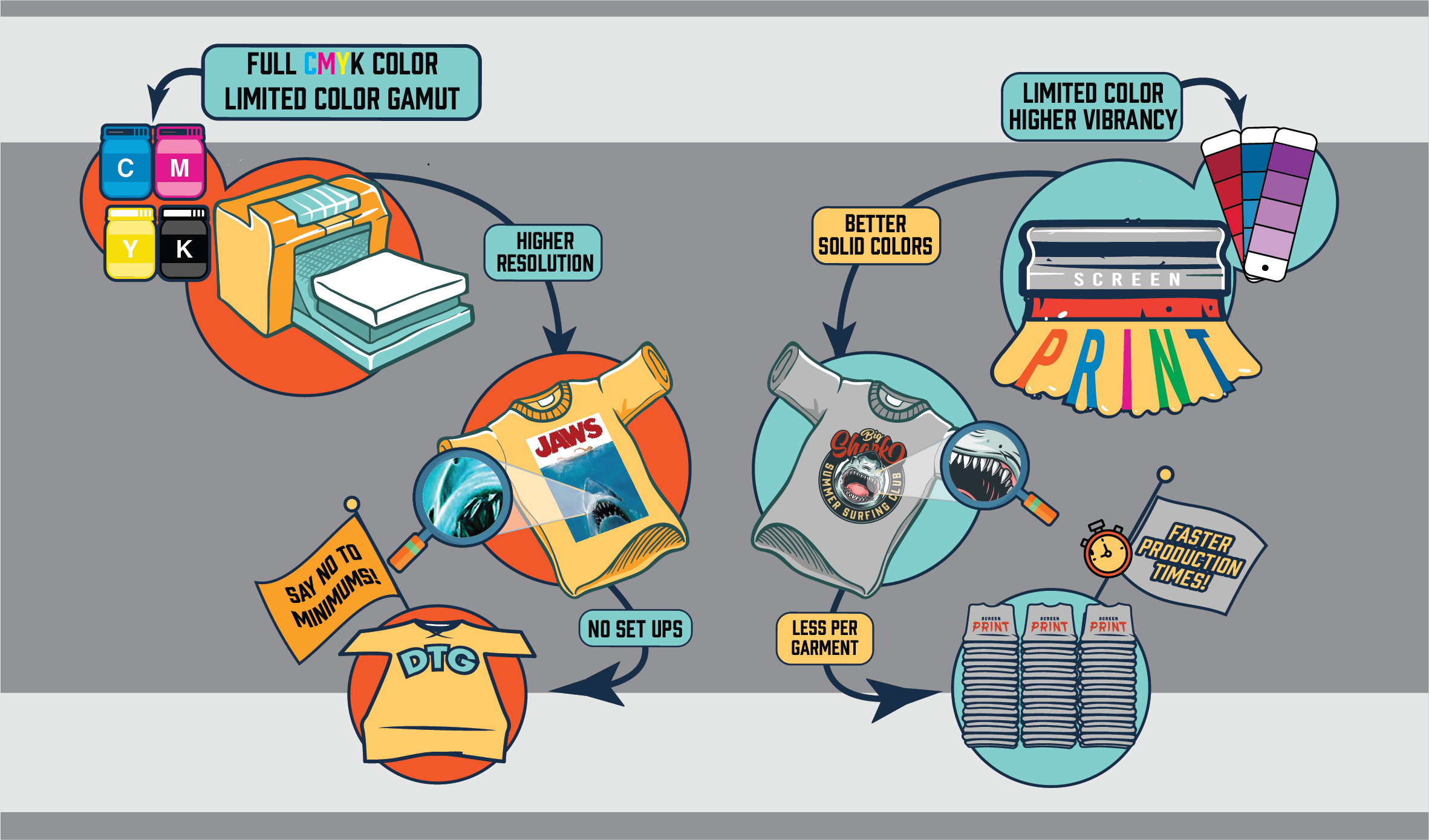The Best Strategy To Use For Tx Tees
The Best Strategy To Use For Tx Tees
Blog Article
What Does Tx Tees Do?
Table of ContentsThe 10-Minute Rule for Tx TeesAbout Tx TeesFascination About Tx TeesGetting My Tx Tees To WorkUnknown Facts About Tx TeesEverything about Tx TeesHow Tx Tees can Save You Time, Stress, and Money.
That brings your overall to about $1,900 gross and shipping. Add up other prices, like the variety of utilities it takes to run the shop and the expense of ink and emulsion per layout. t-shirt printing. Take the print below for instance. This is a one-color photo, so the price of ink per t shirt is around 20 cents.The solution needs to only be a few cents because you 'd only need to layer one display for this job. Generally, printers attempt to make up to 45% profit on a print job.

With DTF, you can publish a handful of t-shirts, or just one. Utilize the same calculator as the area over to calculate just how much earnings you would certainly use DTF transfers. Compare the prices and earnings to whichever technique speaks ideal to your arrangement and process. Both display printing and DTF have their niches worldwide.
Facts About Tx Tees Uncovered
The very best method to know? Ask about and see what printing shop like your own are doing. embroidery shop. Attempt both out and see which you like much better
When you're selecting what sort of printing approach to use for printing your art work layouts on your garments, it is very important that you know the differences between these two methods so you can maximize outcomes while minimizing costs. Display printing is the most generally made use of strategy for publishing styles on textiles.
DTG printing is additionally referred to as area or straight to garment printing due to the fact that it publishes just what is required rather of making a display as display printers do. https://allmyfaves.com/txtees02?tab=TX%20Tees. Display printing functions by screen filler squeegee display printing ink display mesh screen, then transferring the picture to garment using warmth and/or stress
The DTG printer uses unique dye-sublimation inks that are applied right into a pre-designed picture by an electronic printing system. The inks enter into the textile, enabling dynamic shades and outstanding detail. It's likewise recognized as area or straight to garment printing since it publishes just what is required as opposed to making a screen as display printers do.
Excitement About Tx Tees
First, it's much faster - you can publish a fullcolor picture in mins, as opposed to hours for screen printing. Second, there's no established time or expenses entailed - you can print any design you like, without having to develop a display first. Third, there's no waste - due to the fact that display printers display print one layout each time, they need to evaluate each color individually.
The paper is extremely pricey and can just be utilized when. Once it's printed on, it has actually to be disposed of. - The initial purchase rate is lower than the ahead of time financial investment of DTG printers- You can publish multi-color styles one screen at once rather than needing to publish each color separately like DTG printing.

The Best Guide To Tx Tees
Rather of utilizing display mesh as display printers do, color sublimation printers use laser innovation to move your photos onto garments or paper. A heat process transfers the dye from its solid-state straight right into the gas phase which in turn fuses it onto material substratums when they are rapidly heated to heats under high stress.
Sublimation printing is environment-friendly. It makes use of much less water than screenprinting, and since it doesn't entail using damaging solvents, it's risk-free for all sorts of garments. The color sublimation inks are additionally odorless when cured, unlike display printers basics that use unsafe chemicals throughout the display printing procedure that leave behind an unpleasant odor.
They likewise save money on costly devices like exposure systems because dye sublimation printers do not call for a UV direct exposure system or a flash remedy oven that is commonly utilized in display printing (custom cap printing). What is direct to garment printing (DTG Printing)? DTG printing is an electronic screenprinting process that publishes straight onto fabric making use of specialized inkjet printers
All About Tx Tees
DTG printing provides many advantages over traditional screenprinting, consisting of the capability to print photo high quality pictures, higher shade vibrancy, and the capability to print styles on darker fabrics. DTG printers work by heating up the fabric ink up until it develops into a gas. The gas then penetrates the fabric, bonding with the fibers to develop a permanent print.

Screen printers merely prepare their display after that begin publishing up until they run out of product or ink.- There is a variety of skilled screen printers all over the world, which can be practical for novices. - It's a slower process - screen printers often need to await the ink to completely dry prior to they can print the next shade- Screen printers call for manual work, so there's a higher knowing contour and it takes longer to generate a top notch layout- Screen printing isn't as accurate as DTG printing, so you might get some "blood loss" of colors from one part of the picture onto another otherwise done effectively.
Little Known Questions About Tx Tees.
Instead of making use of screen mesh as display printers do, dye sublimation printers utilize laser technology to move your photos onto garments or paper. A warm procedure moves the dye from its solid-state straight into the gas stage which in turn merges it onto material substrates when they are quickly warmed to high temperatures under high stress.
Sublimation printing is environmentally friendly. It makes use of less water than screenprinting, and since it does not involve using dangerous solvents, it's secure for all kinds of apparel. The dye sublimation inks are additionally odorless when healed, unlike display printers that use dangerous chemicals throughout the screen printing process that leave an undesirable odor.
They also save cash on costly tools like direct exposure units because color sublimation printers don't need a UV direct exposure device or a flash cure oven that is usually utilized in display printing. What is straight to garment printing (DTG Printing)? DTG printing is an electronic screenprinting process that publishes straight onto material making use of specialized inkjet printers.
The Buzz on Tx Tees
DTG printing uses lots of advantages over standard screenprinting, including the ability to print photographic quality photos, better shade vibrancy, and the capability to publish designs on darker fabrics. DTG printers work by warming the textile ink till it becomes a gas. The gas then penetrates the fabric, bonding with the fibers to produce a permanent print.
Report this page